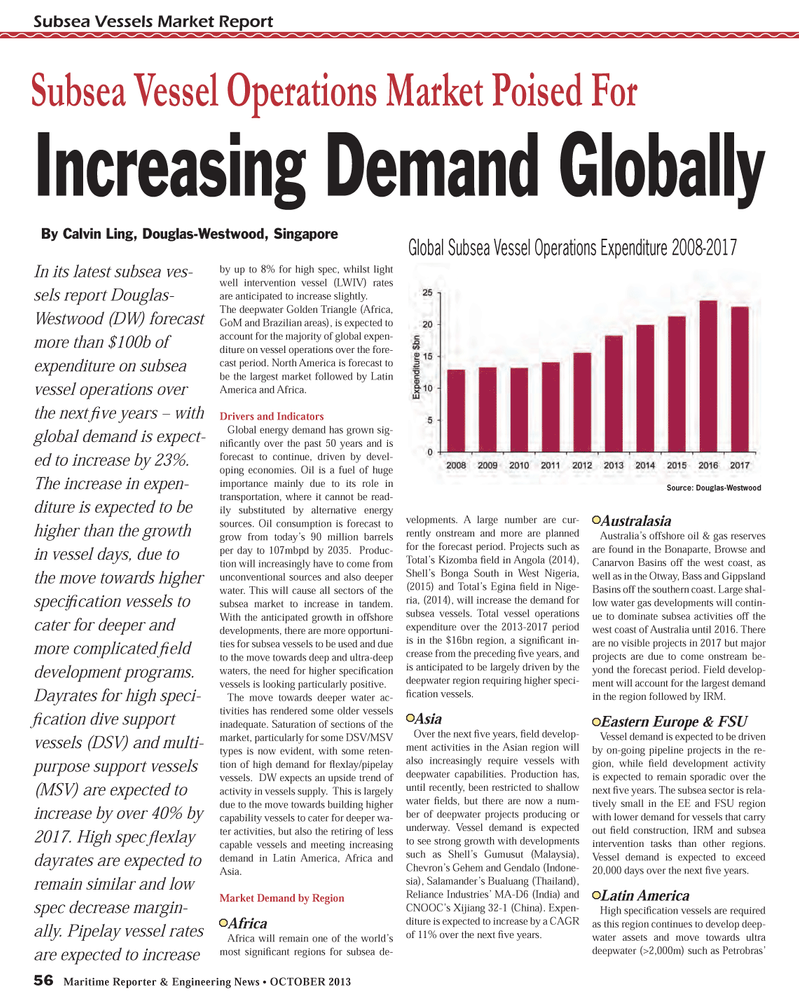
Page 56: of Maritime Reporter Magazine (October 2013)
Marine Design & Construction
Read this page in Pdf, Flash or Html5 edition of October 2013 Maritime Reporter Magazine
56 Maritime Reporter & Engineering News ? OCTOBER 2013 by up to 8% for high spec, whilst light well intervention vessel (LWIV) rates are anticipated to increase slightly. The deepwater Golden Triangle (Africa, GoM and Brazilian areas), is expected to account for the majority of global expen-diture on vessel operations over the fore-cast period. North America is forecast to be the largest market followed by Latin America and Africa. Drivers and IndicatorsGlobal energy demand has grown sig- niÞ cantly over the past 50 years and is forecast to continue, driven by devel-oping economies. Oil is a fuel of huge importance mainly due to its role in transportation, where it cannot be read-ily substituted by alternative energy sources. Oil consumption is forecast to grow from today?s 90 million barrels per day to 107mbpd by 2035. Produc-tion will increasingly have to come from unconventional sources and also deeper water. This will cause all sectors of the subsea market to increase in tandem. With the anticipated growth in offshore developments, there are more opportuni-ties for subsea vessels to be used and due to the move towards deep and ultra-deep waters, the need for higher speciÞ cation vessels is looking particularly positive.The move towards deeper water ac-tivities has rendered some older vessels inadequate. Saturation of sections of the market, particularly for some DSV/MSV types is now evident, with some reten-tion of high demand for ß exlay/pipelay vessels. DW expects an upside trend of activity in vessels supply. This is largely due to the move towards building higher capability vessels to cater for deeper wa-ter activities, but also the retiring of less capable vessels and meeting increasing demand in Latin America, Africa and Asia.Market Demand by RegionAfricaAfrica will remain one of the world?s most signiÞ cant regions for subsea de- velopments. A large number are cur- rently onstream and more are planned for the forecast period. Projects such as Total?s Kizomba Þ eld in Angola (2014), Shell?s Bonga South in West Nigeria, (2015) and Total?s Egina Þ eld in Nige- ria, (2014), will increase the demand for subsea vessels. Total vessel operations expenditure over the 2013-2017 period is in the $16bn region, a signiÞ cant in- crease from the preceding Þ ve years, and is anticipated to be largely driven by the deepwater region requiring higher speci-Þ cation vessels. AsiaOver the next Þ ve years, Þ eld develop- ment activities in the Asian region will also increasingly require vessels with deepwater capabilities. Production has, until recently, been restricted to shallow water Þ elds, but there are now a num- ber of deepwater projects producing or underway. Vessel demand is expected to see strong growth with developments such as Shell?s Gumusut (Malaysia), Chevron?s Gehem and Gendalo (Indone- sia), Salamander?s Bualuang (Thailand), Reliance Industries? MA-D6 (India) and CNOOC?s Xijiang 32-1 (China). Expen- diture is expected to increase by a CAGR of 11% over the next Þ ve years. AustralasiaAustralia?s offshore oil & gas reserves are found in the Bonaparte, Browse and Canarvon Basins off the west coast, as well as in the Otway, Bass and Gippsland Basins off the southern coast. Large shal- low water gas developments will contin-ue to dominate subsea activities off the west coast of Australia until 2016. There are no visible projects in 2017 but major projects are due to come onstream be-yond the forecast period. Field develop-ment will account for the largest demand in the region followed by IRM.Eastern Europe & FSUVessel demand is expected to be driven by on-going pipeline projects in the re-gion, while Þ eld development activity is expected to remain sporadic over the next Þ ve years. The subsea sector is rela- tively small in the EE and FSU region with lower demand for vessels that carry out Þ eld construction, IRM and subsea intervention tasks than other regions. Vessel demand is expected to exceed 20,000 days over the next Þ ve years. Latin AmericaHigh speciÞ cation vessels are required as this region continues to develop deep-water assets and move towards ultra deepwater (>2,000m) such as Petrobras? Subsea Vessels Market ReportSubsea Vessel Operations Market Poised For Increasing Demand Globally By Calvin Ling, Douglas-Westwood, Singapore Source: Douglas-Westwood Global Subsea Vessel Operations Expenditure 2008-2017 In its latest subsea ves-sels report Douglas- Westwood (DW) forecast more than $100b of expenditure on subsea vessel operations over the next Þ ve years ? with global demand is expect-ed to increase by 23%. The increase in expen- diture is expected to be higher than the growth in vessel days, due to the move towards higher speciÞ cation vessels to cater for deeper and more complicated Þ eld development programs. Dayrates for high speci-Þ cation dive support vessels (DSV) and multi-purpose support vessels (MSV) are expected to increase by over 40% by 2017. High spec ß exlay dayrates are expected to remain similar and low spec decrease margin- ally. Pipelay vessel rates are expected to increase MR #10 (50-57).indd 56MR #10 (50-57).indd 5610/3/2013 4:38:11 PM10/3/2013 4:38:11 PM

 55
55

 57
57
